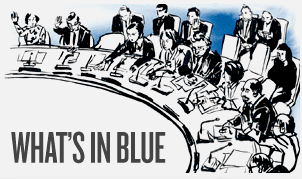Open Debate and Resolution on Conflict Prevention
Tomorrow (21 August), the Security Council will hold an open debate on conflict prevention, with Secretary-General Ban Ki-moon and High Commissioner for Human Rights Navi Pillay as briefers. A vote is expected on a draft resolution on conflict prevention during the debate. Following four meetings, the text was first put under silence procedure on Tuesday morning. Following silence being broken, it was once again put under silence on Tuesday afternoon and is now in blue.
On 5 August, the UK circulated a concept note for the event (S/2014/572). (For more background information and analysis, please also see SCR’s Monthly Forecast brief on conflict prevention.)
The draft resolution contains a number of core conflict prevention themes which are meant to reinforce the Council’s role in conflict prevention. First, there is recognition of the importance of early warning mechanisms and a commitment to taking preventive action. Second, there is a commitment to the settlement of conflict through peaceful means and an acknowledgement that Chapter VI has not been fully utilised thus far. Third, there is language regarding violations of human rights and humanitarian law as indicators of conflict onset and escalation as well as the role of certain actors in the UN system to raise awareness. Fourth, the significance of accountability as a preventative measure is emphasised, including through the work of ad hoc and mixed tribunals and the International Criminal Court. Fifth, efforts toward cooperation with regional and sub-regional organisations on conflict prevention in accordance with Chapter VIII are highlighted, including the need to pursue these initiatives further at a working level.
During negotiations on the draft resolution, there were a few issues requiring lengthy discussion among Council members, mainly due to the objections of one permanent member. It appears that this member had an overall issue with what it saw as language that could be interpreted as an expansion of the Secretary-General’s mandate in conflict prevention. A specific issue was related to references to Article 99 of the Charter within the context of conflict prevention. It seems that the idea that Article 99 gave the Secretary-General a conflict prevention role in relation to the Council was questioned. (While the draft that went into blue retains references to Article 99, the specific linkage to the Secretary-General’s role in conflict prevention was weakened.) Apparently the same member expressed some skepticism regarding what specifically constitutes an “early warning” of conflict, such as violations of human rights and humanitarian law. Another critical point in negotiations concerned the request for a report by the Secretary-General, which most Council members supported and has been retained in the draft.
During the negotiation process, there were a number of additions made to the draft resolution, primarily at the request of various elected members, including content on: the importance of civil society in conflict prevention, the role of peacebuilding and the Peacebuilding Commission in particular, counter-terrorism as a complement to conflict prevention, sanctions as a preventative measure, cooperation with regional organisations, references to the Special Representative on Sexual Violence in Conflict and the Special Representative on Children and Armed Conflict, affirmation of the responsibility to protect, and the role of women in conflict prevention.
Calls for the Council to more appropriately and in a more timely manner address conflict prevention have been in the offing for decades. Addressing the Council on 25 September 1985, as part of the 40th anniversary of the founding of the UN, then- Secretary General Boutros-Boutros Ghali stated that as “crises have frequently been brought before the Council too late for preventive action, it would seem to follow that the Council might well establish a procedure to keep the world under continuing survey in order to detect nascent causes of tension. In this same context, there would seem to be substantial benefit to be derived from an agreed procedure for fact-finding which could be easily and quickly implemented where instances of potential conflict are detected.” Yet little has changed, with some early warning mechanisms such as the “horizon-scanning briefings” waning due to excessive concern by the Secretariat regarding potential political sensitivities within the Council. In addition, Council members have also been rather hesitant to use “any other business” to discuss issues of concern not on the agenda.
The draft resolution requests the Secretary-General to submit a report to the Council on actions taken to strengthen and promote conflict prevention within the UN system, including through cooperation with regional and sub-regional organisations. The report is due by 31 August 2015, thus providing an opportunity for the Council to take up the subject once again in a year. What is less clear is whether this resolution will be able to improve the Council’s poor performance on conflict prevention. While reiterating many of the fundamental tenets related to conflict resolution, it seems unlikely that the resolution will change the standard operating procedures of the Council in this area. Instead what may be needed is a critical reappraisal of the Council’s approach to conflict prevention, possibly by an independent body which could be appointed to review the Council’s conflict prevention practice and offer policy recommendations.

